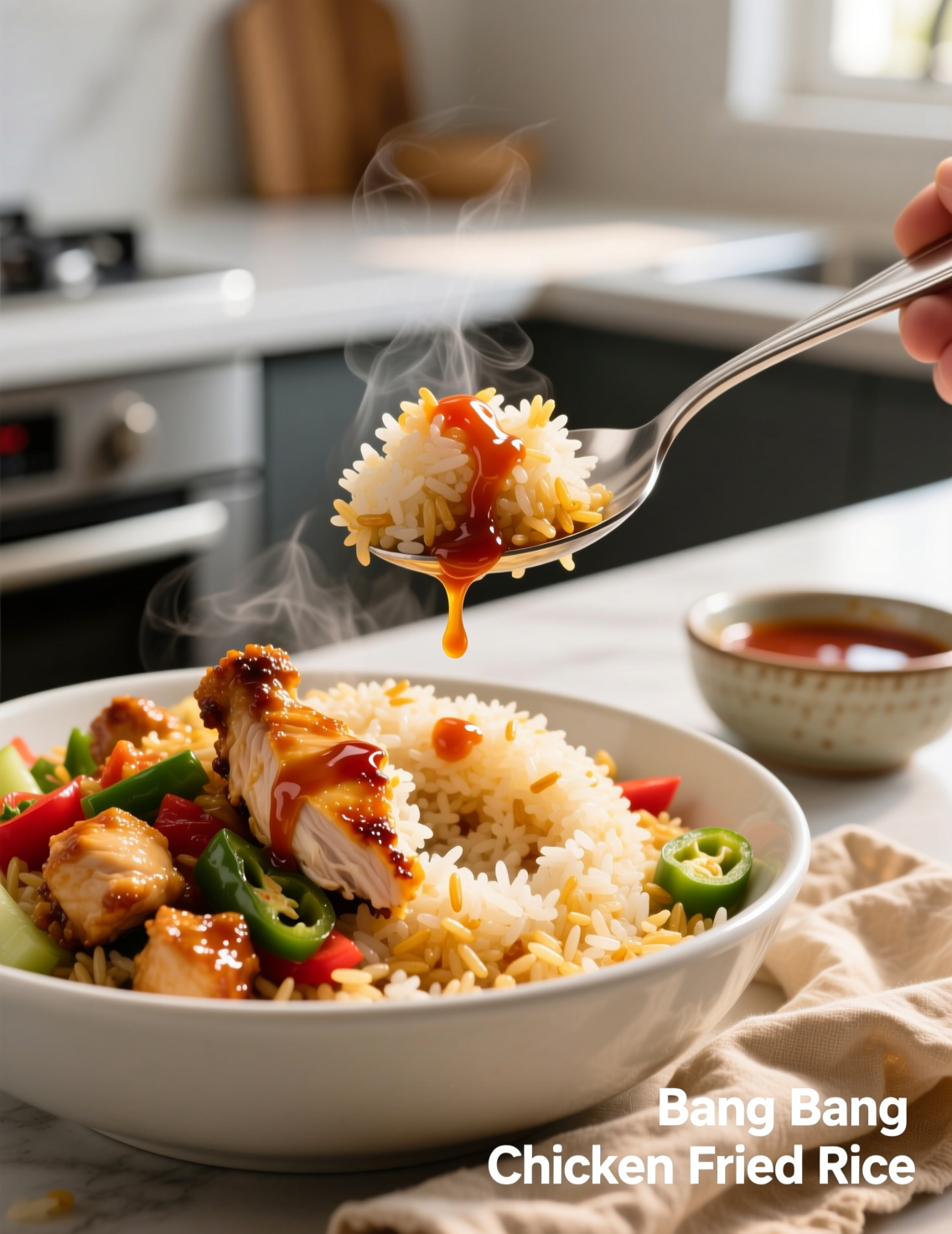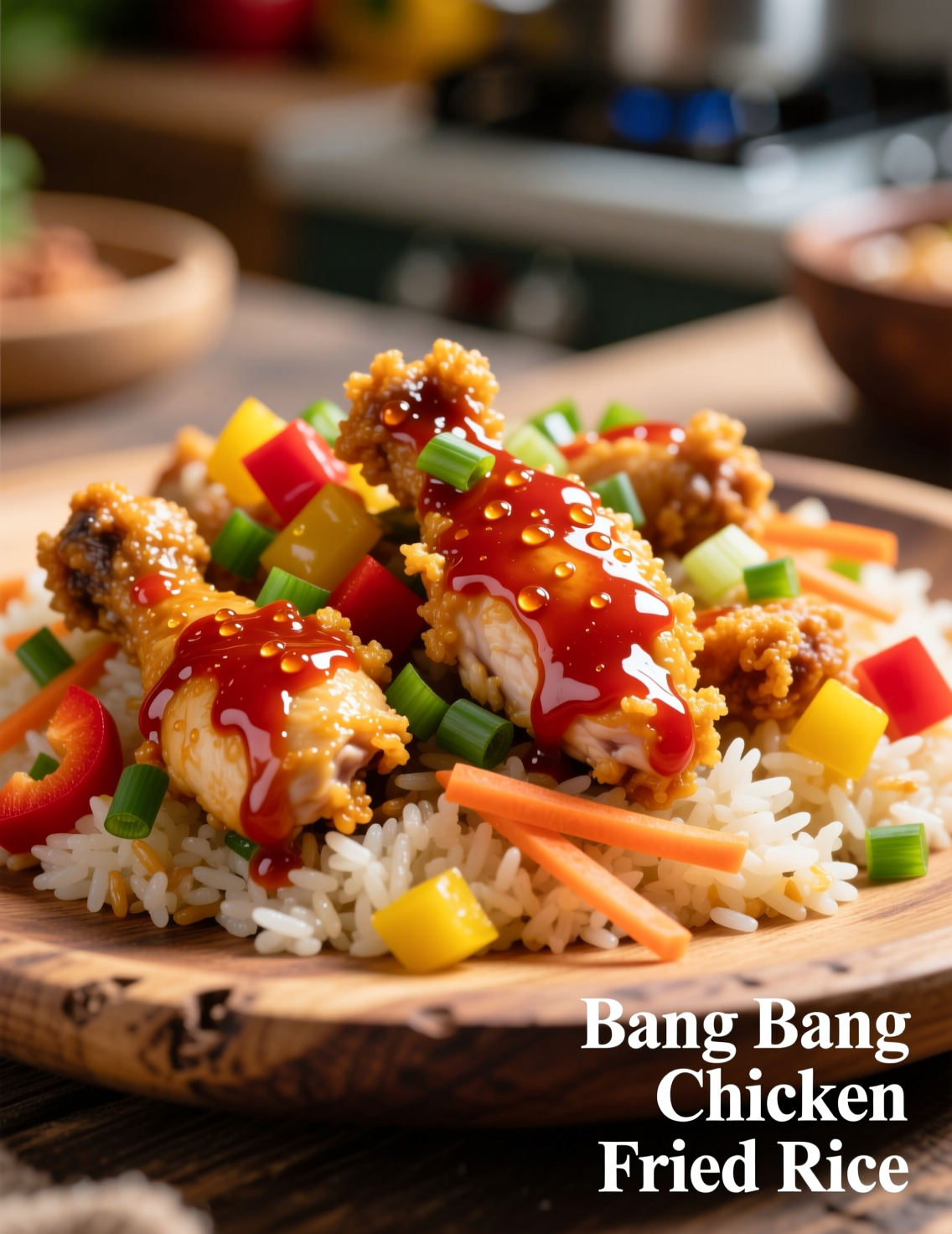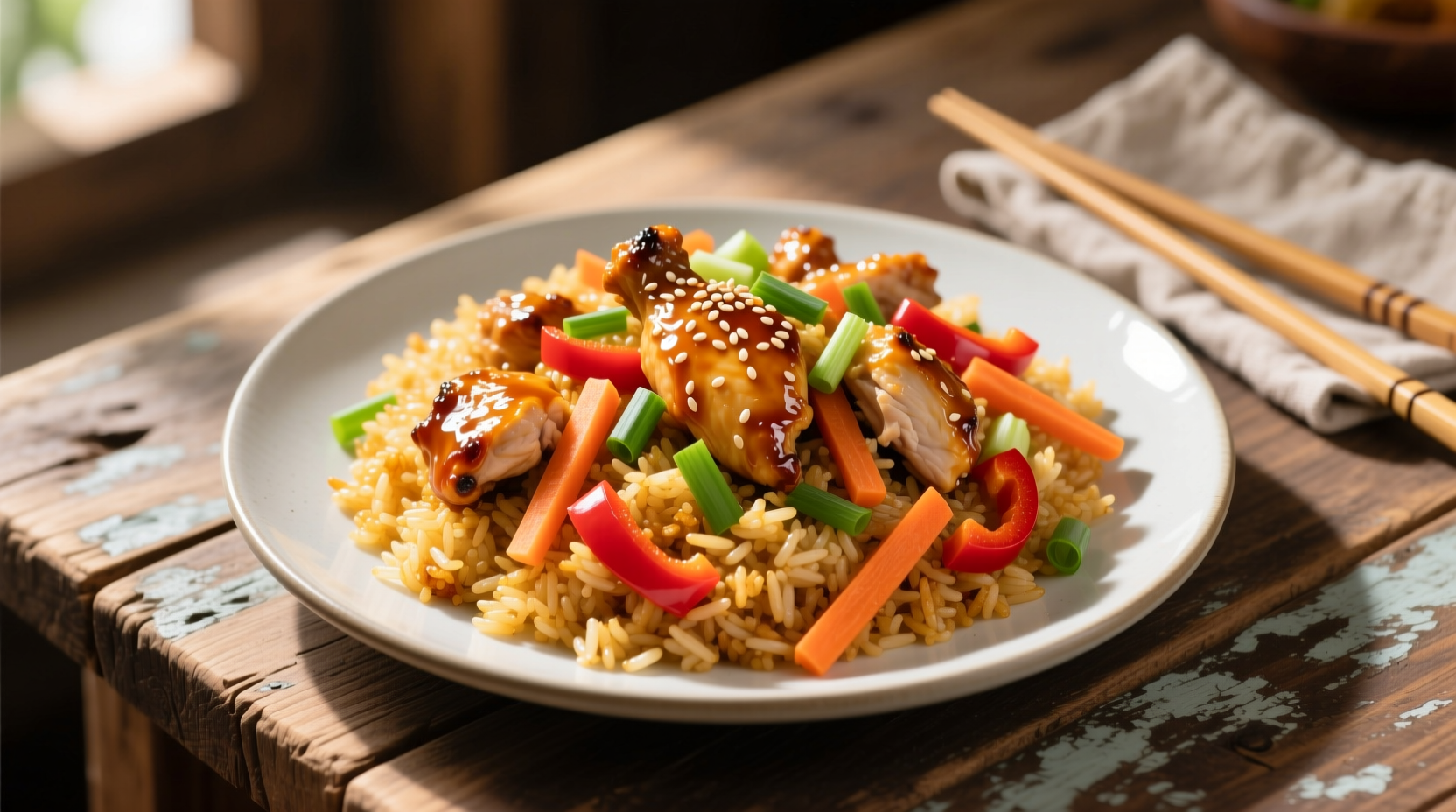The first spoonful of bang bang chicken fried rice will always surprise you. Sweet, spicy, creamy, crunchy—it throws everything at your tastebuds in one go. But making it right isn’t just throwing some chicken into rice with sauce. It’s about balance, control, and knowing when to let heat do the talking. This article breaks down the recipe, not like a casual food blog, but the way a chef thinks about it. By the end, you’ll understand how to cook it, serve it, and even tweak it for your own kitchen.
What Makes Bang Bang Chicken Fried Rice Different
Fried rice on its own is a blank canvas. Add eggs, scallions, a few aromatics, and you’ve got comfort food. But bang bang chicken fried rice takes it into a louder, more playful territory. The dish pulls from the bang bang sauce made popular in Asian-fusion restaurants. Mayo, chili paste, sweet chili sauce, sometimes a drizzle of honey—it’s bold, unapologetic, and yet silky.
This isn’t the subtle fried rice you pair with steamed dumplings. This is fried rice with personality. A dish that can stand alone at the center of the table.
The Role of the Sauce
Every chef knows: sauce defines the dish. The bang bang sauce is creamy with heat that lingers but doesn’t burn. You build it with mayonnaise as the base, Sriracha for the heat, sweet chili sauce for stickiness, and rice vinegar or lime for acidity. Some cooks sneak in garlic powder or smoked paprika to deepen it.
Here’s the trick: don’t drown the rice in sauce. If you add too much, it becomes cloying and heavy. A thin glaze across the rice grains and chicken bites is perfect. Think coating, not soaking.
Choosing the Right Chicken
You can’t hide behind sauce if your chicken isn’t cooked right. Boneless skinless chicken thighs are a chef’s best pick here. They’ve got fat, flavor, and they don’t dry out under the searing heat of a wok. Breast meat works too, but it demands stricter control on timing. A minute too long and you’re chewing rubber.
Dice the chicken into bite-sized cubes. Dust lightly with cornstarch before frying. That thin layer does two things—it locks in moisture and gives the surface just enough crispness to grip the sauce.
The Rice: Old is Gold
No fried rice dish works with freshly cooked rice. If you try, you’ll end up with clumps that refuse to separate. Day-old rice is the golden rule. The grains have dried out just enough to fry cleanly, staying separate and chewy.
Professional kitchens often spread hot rice on trays, chill it quickly, and use it the next day. At home, you can cook rice in the morning, refrigerate it uncovered for a few hours, and then it’s ready by dinner.

Technique: Heat Rules Everything
The heart of fried rice is the wok or a heavy skillet if you don’t have one. High heat is non-negotiable. You want smoke kissing the oil, the kind of heat that caramelizes soy sauce in seconds. Medium heat just stews everything.
Start with neutral oil—canola, sunflower, or peanut. Toss aromatics like garlic and ginger fast. They should sizzle and perfume the air in less than 20 seconds. Then in goes chicken, rice, vegetables, and finally sauce. Each ingredient hits the wok in order, never crowding.
Crowding kills fried rice. It steams instead of frying. Always cook in batches if your pan is small.
Vegetables That Work Best
Bang bang chicken fried rice isn’t about loading every veggie from the fridge. Keep it sharp and focused. Carrots, bell peppers, and peas give color and sweetness. Scallions are essential for freshness. Some chefs fold in shredded cabbage at the end for crunch.
The trick is cutting vegetables into small, even pieces. Too big, and they sit heavy against the rice. Too small, and they vanish. Precision pays off here.
Step-by-Step Recipe (4 Servings)
Ingredients
- 2 cups cooked jasmine rice (day-old preferred)
- 1 lb boneless skinless chicken thighs, diced
- 2 tbsp cornstarch
- 3 tbsp neutral oil (canola, peanut, or sunflower)
- 2 garlic cloves, minced
- 1-inch ginger, minced
- ½ cup diced carrots
- ½ cup bell pepper, diced
- ½ cup frozen peas
- 3 eggs, lightly beaten
- 3 scallions, chopped
- 2 tbsp soy sauce
- 1 tbsp rice vinegar
Bang Bang Sauce:
- ½ cup mayonnaise
- 3 tbsp sweet chili sauce
- 2 tbsp Sriracha
- 1 tbsp honey
- 1 tsp rice vinegar or lime juice
Method
- Toss chicken with cornstarch. Heat 1 tbsp oil in wok over high heat. Fry chicken until golden, 5–6 minutes. Remove and set aside.
- Add another tbsp oil. Toss garlic and ginger for 15 seconds. Add carrots, peppers, and peas. Stir-fry until just tender. Remove and keep warm.
- Pour in last tbsp oil. Scramble eggs quickly, breaking them into soft curds.
- Add rice. Spread it across the wok, let it fry untouched for 30 seconds, then stir. Repeat twice. This gives a light crispness.
- Return chicken and vegetables. Splash soy sauce and vinegar, tossing fast.
- Stir in bang bang sauce a spoonful at a time, just enough to coat.
- Finish with scallions. Serve hot.
Why Cornstarch Is More Than Just Coating
Many home cooks skip the cornstarch step. Don’t. That thin layer isn’t about crispiness alone. It creates a barrier between the chicken’s juices and the pan. Without it, the meat leaks water, steaming instead of searing. With it, the chicken browns clean and keeps flavor locked inside. It’s a small step that makes a professional difference.

Common Mistakes to Avoid
One mistake I see often is sauce overload. People think more sauce equals more flavor. Wrong. It turns the dish into mush. Another mistake—cooking rice straight from the pot. It clumps, sticks, and fights you every second.
Also, don’t forget the eggs. They’re not just filler; they give creaminess that balances the spice. Skip them and the texture feels flat.
Flavor Balancing: Heat, Cream, Sweet
The beauty of bang bang sauce is contrast. Too much spice without cream burns out the palate. Too much mayo without acid feels greasy. The ratio in the recipe is balanced, but chefs adjust by taste.
Want more heat? Add extra Sriracha or even Thai bird’s eye chilies for sharper bite. Want lighter cream? Swap half the mayo for Greek yogurt. It keeps richness but trims heaviness.
Nutrition and Health Notes
Bang bang chicken fried rice isn’t the lightest dish on the menu. A serving runs around 550–600 calories, depending on oil use. Protein is strong at about 30 grams per serving, while carbs average 50 grams.
Professionals often tweak recipes to lighten them. Using avocado mayo cuts saturated fat. Swapping chicken thighs for breast lowers calories. Adding extra vegetables boosts fiber and micronutrients without wrecking the flavor.
Variations and Professional Twists
Chefs love pushing fried rice into new territory. Some swap chicken for shrimp—shrimp’s sweetness plays beautifully against the spicy sauce. Others go vegetarian, using crispy tofu dusted in cornstarch.
Another twist is using brown rice or even cauliflower rice for a lighter version. The key is keeping that balance of crisp rice, juicy protein, and just enough sauce.
Serving and Pairing Suggestions
Bang bang chicken fried rice is a meal by itself, but sides can elevate it. A crisp cucumber salad cuts through richness. Light miso soup balances the spice with umami. For drinks, sparkling water with lime or light beer pairs well.
In professional settings, plating matters too. A shallow bowl works best, letting the sauce glaze catch the light. Garnish with extra scallions or toasted sesame seeds for visual contrast.
The Rising Trend of Fusion Fried Rice
Bang bang chicken fried rice fits neatly into the rising trend of Asian-fusion comfort food. Restaurants across the US and UK are putting it on menus, sometimes with extravagant touches like kimchi or crispy shallots. Social media loves it—TikTok videos with “bang bang” anything rack up millions of views.
Chefs see it as a gateway dish. A way to bring bold Asian-inspired flavors into Western kitchens without intimidating new eaters. That’s part of its charm.
Final Thoughts
Bang bang chicken fried rice isn’t just another fried rice variation. It’s a dish that teaches restraint, balance, and technique. You learn to handle heat, manage sauce, and coax crispness from rice.
For professionals, it’s a solid menu item. For home cooks, it’s a masterclass in layering flavors. Make it once, and you’ll find yourself tweaking, refining, and making it your own. That’s the beauty of it—it never stands still.
FAQs
What is Bang Bang Chicken Fried Rice?
A flavorful fried rice dish with creamy, spicy bang bang sauce and tender chicken.
How many servings does this recipe make?
This recipe serves 4 people.
Can I use chicken breast instead of thighs?
Yes, but thighs stay juicier and more flavorful.
Why should I use day-old rice?
Day-old rice fries better and stays separate, avoiding mushiness.
What makes bang bang sauce special?
It combines creamy mayo, sweet chili, Sriracha, and a touch of acidity for balance.
Can I make this dish vegetarian?
Yes, swap chicken for tofu or extra vegetables.
Do I need a wok to cook this?
No, but a wok gives best results for high-heat frying.
How can I adjust the spice level?
Add more Sriracha for heat or reduce it for milder flavor.
Is cornstarch necessary for the chicken?
Yes, it locks in moisture and gives a light crisp surface.
Can I prepare this ahead of time?
You can prep ingredients and rice in advance, but cook fresh for best texture.
What sides pair well with this dish?
Cucumber salad, miso soup, or light drinks complement it perfectly.
How do I prevent the rice from sticking?
Fry over high heat in small batches and avoid overcrowding the pan.
Can I use brown rice instead of jasmine?
Yes, but cook it fully and let it dry slightly before frying.
How long does it take to cook?
About 25–30 minutes from start to finish.
What’s the best way to serve it?
In a shallow bowl, garnished with scallions or toasted sesame seeds.

Mariana is a passionate home cook who creates delicious, easy-to-follow recipes for busy people. From energizing breakfasts to satisfying dinners and indulgent desserts, her dishes are designed to fuel both your body and hustle.
When she’s not in the kitchen, she’s exploring new flavors and dreaming up her next recipe to share with the Foodie Hustle community.

